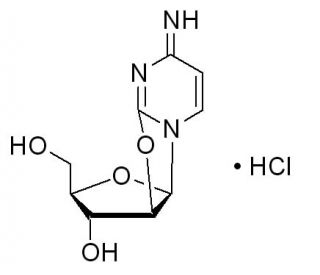

Ancitabine hydrochloride (CAS 10212-25-6)
QUICK LINKS
Ancitabine hydrochloride, also known as cytosine arabinoside hydrochloride, is a nucleoside analog where the sugar component is arabinose instead of the more common ribose or deoxyribose found in natural nucleosides. This modification plays a crucial role in the chemical′s function, particularly in the context of nucleic acid synthesis and research related to enzymatic processes involving DNA and RNA. The primary mechanism of action of ancitabine hydrochloride involves its incorporation into DNA and RNA. Due to its structural similarity to cytidine, ancitabine can be incorporated into nucleic acids during the replication and transcription processes. However, the arabinose sugar creates structural disruptions in the nucleic acid chain, leading to the inhibition of DNA polymerase and RNA polymerase activities. This results in the termination or significant slowing of nucleic acid synthesis. Ancitabine hydrochloride has been used extensively to study the effects of nucleoside analogs on DNA and RNA synthesis. Researchers utilize this compound to understand how changes in the sugar moiety of nucleotides affect the elongation and stability of nucleic acid chains. This is crucial for elucidating the fundamental mechanisms of genetic replication and transcription. Furthermore, ancitabine hydrochloride serves as an important tool in enzymology, particularly in studies involving DNA polymerases and RNA polymerases. It helps in characterizing the specificity and kinetics of these enzymes, as ancitabine′s incorporation can inhibit these enzymes in a manner that is informative for understanding how nucleotide structure affects enzyme activity.
Ancitabine hydrochloride (CAS 10212-25-6) References
- Antiviral effect of antileukemic drugs N4-behenoyl-1-beta-D-arabinofuranosylcytosine (BH-AC) and 2,2'-anhydro-1-beta-D-arabinofuranosylcytosine (cyclo-C) against human cytomegalovirus. | Nakamura, K., et al. 1990. J Med Virol. 31: 141-7. PMID: 1696958
- Label-free detection and dynamic monitoring of drug-induced intracellular vesicle formation enabled using a 2-dimensional matched filter. | Aftab, O., et al. 2014. Autophagy. 10: 57-69. PMID: 24169509
- Detection of cell aggregation and altered cell viability by automated label-free video microscopy: a promising alternative to endpoint viability assays in high-throughput screening. | Aftab, O., et al. 2015. J Biomol Screen. 20: 372-81. PMID: 25520371
- Large-Scale Phenotype-Based Antiepileptic Drug Screening in a Zebrafish Model of Dravet Syndrome. | Dinday, MT. and Baraban, SC. 2015. eNeuro. 2: PMID: 26465006
- Robust Classification of Small-Molecule Mechanism of Action Using a Minimalist High-Content Microscopy Screen and Multidimensional Phenotypic Trajectory Analysis. | Twarog, NR., et al. 2016. PLoS One. 11: e0149439. PMID: 26886014
- HDAC and PI3K Antagonists Cooperate to Inhibit Growth of MYC-Driven Medulloblastoma. | Pei, Y., et al. 2016. Cancer Cell. 29: 311-323. PMID: 26977882
- An unbiased high-throughput drug screen reveals a potential therapeutic vulnerability in the most lethal molecular subtype of pancreatic cancer. | Pan, CH., et al. 2020. Mol Oncol. 14: 1800-1816. PMID: 32533886
Ordering Information
| Product Name | Catalog # | UNIT | Price | Qty | FAVORITES | |
Ancitabine hydrochloride, 1 g | sc-217650 | 1 g | $70.00 |
